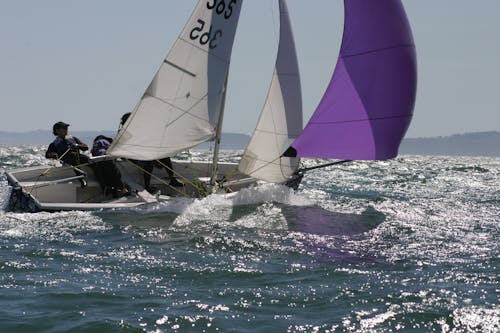 |
| Sailing |
The expression "speed" alludes both to speed and bearing. As connected to wind, evident breeze speed (VA) is the air speed following up on the main edge of the most forward sail or as experienced by instrumentation or team on a moving cruising make. In nautical phrasing, wind speeds are typically communicated in tangles and wind points in degrees. All cruising art achieve a steady forward speed (VB) for a given genuine breeze speed (VT) and purpose of sail. The art's purpose of sail influences its speed for a given genuine breeze speed. Ordinary cruising make can't get control from the breeze in a "no-go" zone that is around 40° to 50° far from the genuine breeze, contingent upon the art. Similarly, the straightforwardly downwind speed of all traditional cruising make is restricted to the genuine breeze speed. As a sailboat cruises further from the breeze, the evident Sailingbreeze winds up littler and the parallel segment turns out to be less; pontoon speed is most elevated on the pillar reach. So as to act like an airfoil, the sail on a sailboat is sheeted farther as the course is further off the wind. As an iceboat cruises further from the breeze, the evident breeze increments marginally and the vessel speed is most elevated on the expansive reach. So as to act like an airfoil, the sail on an iceboat is sheeted in for every one of the three points of sail. Sailing
Lift and delay sails Sailing
Streamlined power parts for two of sail. Sailing
Left-hand vessel: Down wind with segregated wind stream like a parachute—prevalent drag segment pushes the pontoon with small behaving minute. Sailing
Right-hand vessel: Up twist (close-pulled) with appended wind stream like a wing—prevalent lift segment both pushes the pontoon and adds to heel. Sailing
Principle articles: Lift (power) and Lift-initiated drag Sailing Sailing
Lift on a sail, going about as an airfoil, happens toward a path opposite to the occurrence airstream (the obvious breeze speed for the head cruise) and is a consequence of weight contrasts between the windward and leeward surfaces and relies upon approach, cruise shape, air thickness, and speed of the clear wind. The lift compel results from the normal weight on the windward surface of the sail being higher than the normal weight on the leeward side These weight contrasts emerge related to the bended wind stream. As air pursues a bended way along the windward side of a sail, there is a weight slope opposite to the stream course with higher weight outwardly of the bend and lower weight within. To create lift, a sail must present an "approach" between the harmony line of the sail and the clear wind speed. Approach is an element of both the specialty's purpose of sail and how the sail is balanced as for the obvious wind. Sailing
As the lift created by a sail increments, so lifts initiated drag, which together with parasitic drag establish complete drag, which acts toward a path parallel to the episode airstream. This happens as the approach increments with sail trim or change obviously and makes the lift coefficient increment up to the point of streamlined slow down alongside the lift-initiated drag coefficient. At the beginning of slow down, lift is unexpectedly diminished, as is lift-incited drag. Sails with the obvious breeze behind them (particularly going downwind) work in a slowed down condition. Sailing
Lift and drag are segments of the all out streamlined power on sail, which are opposed by powers in the water (for a watercraft) or on the voyaged surface (for an ice vessel or land cruising make). Sails act in two essential modes; under the lift-transcendent mode, the sail acts in a way practically equivalent to a wing with wind stream appended to the two surfaces; under the drag-prevalent mode, the sail demonstrations in a way comparable to a parachute with wind current in isolates stream, eddying around the sail. Sailing
Lift transcendence (wing mode) Sailing
Sail approaches (α) and coming about (glorified) stream designs for connected stream, most extreme lift, and slowed down for a speculative sail. The stagnation streamlines (red) portray air going to the leeward side (top) from that going to the windward Sailing

No comments:
Post a Comment